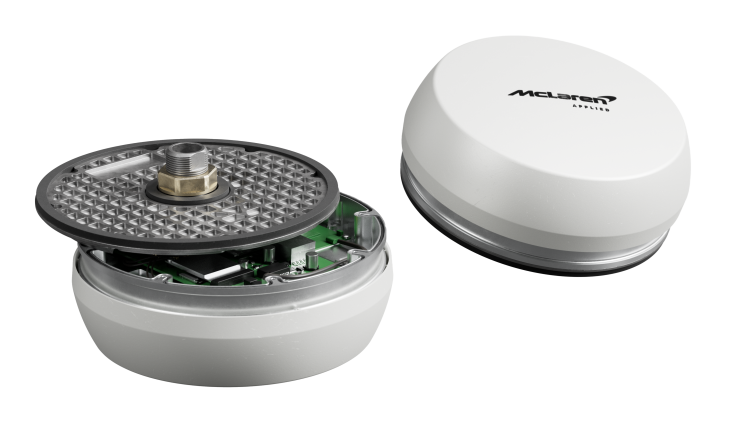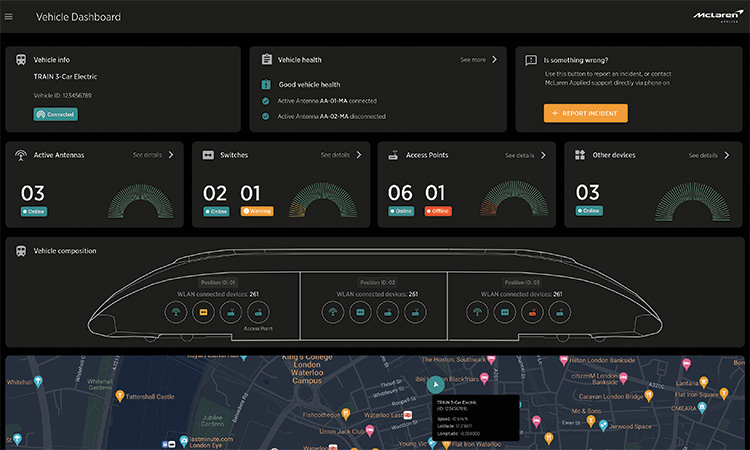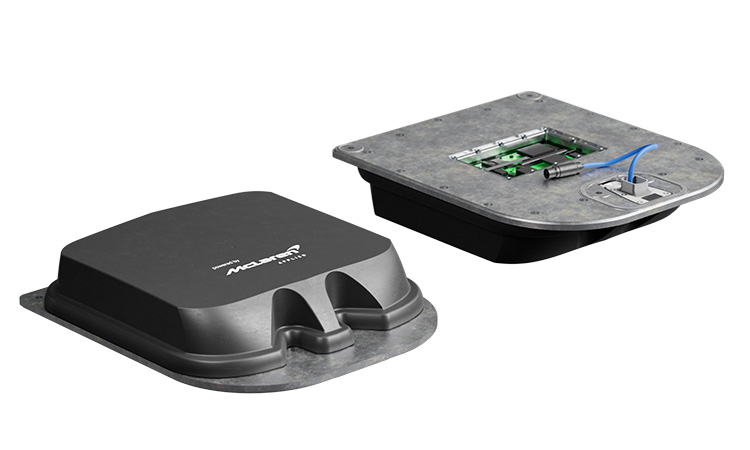Connecting the dots: How McLaren Applied revolutionised connectivity in public transport
- Like
- Digg
- Del
- Tumblr
- VKontakte
- Buffer
- Love This
- Odnoklassniki
- Meneame
- Blogger
- Amazon
- Yahoo Mail
- Gmail
- AOL
- Newsvine
- HackerNews
- Evernote
- MySpace
- Mail.ru
- Viadeo
- Line
- Comments
- Yummly
- SMS
- Viber
- Telegram
- Subscribe
- Skype
- Facebook Messenger
- Kakao
- LiveJournal
- Yammer
- Edgar
- Fintel
- Mix
- Instapaper
- Copy Link
Posted: 11 March 2024 | Pablo Garcia Lopez - McLaren Applied | No comments yet
Pablo Garcia Lopez, Director – Connected Intelligence at McLaren Applied, sat down with Intelligent Transport’s Halimah Haque to discuss how the company’s motorsport expertise is reshaping public transport connectivity, improving real-time data and enhancing passenger experience with innovative software and hardware solutions.


What did McLaren Applied learn from its use of connectivity in motorsport, and how have these learnings been adapted for public transport?
This story began more than 20 years ago, as McLaren Applied worked to solve the connectivity challenges in motorsport. Back then, the company needed to find a way to achieve real-time visibility of its racing cars but, for that to happen, the vehicles needed to be connected at all times. Unfortunately, as circuits are located across the globe, some were in places where coverage and signal was poor, meaning that the standard solutions were not working as required. This meant that a lot of the cars’ sensors were only intermittently transferring data to the control centre. As a result, sections of the track with connectivity ‘black spots’ made the task of having real-time visibility of the vehicle sensors during racing weekends difficult.
Therefore, McLaren Applied began working to develop a software that solved this issue by facilitating handovers between the different ‘connectivity links’ that were available. This meant that, throughout the car’s entire journey around the circuit, it maintained a continuous connection. And so, as that technology was developed and as it evolved, several stakeholders ended up utilising it in Formula 1 and in other racing series.
A few years later, around 2015, we identified similar challenges in transport because, at the end of the day, trains are not much different to cars – both vehicle types move fast and go through regions where connectivity is not what it needs to be, resulting in persistent black spots and patchy connectivity.


Credit: McLaren Applied – McLaren Applied’s Halo 300 solution.
Upon the realisation that the challenge was very similar to the one that we had solved years before in Formula 1, that’s when we started talking to transport operators to see how we could potentially help. A few months later, the foundations of our software product, Fleet Connect, were created. We started by providing the service to some UK customers and, since then, we’ve been developing it further.
However, a few months before COVID-19 arrived, it became evident that better software was only solving part of the problem. Unfortunately, while you can enhance connectivity software on a moving vehicle to a considerable extent, standard connectivity hardware is a huge limitation. If that hardware is not also optimised, you encounter limitations in the vehicle’s performance. This led to our decision to try to solve the next challenge: connectivity hardware in a moving vehicle. As a result, we partnered with Huber+Suhner to develop the 5G Active Antenna. This product represents a significant shift in how a train is connected, completely different to the approach for the last 10 years. In essence, it removes all of the RF cables and routers from inside the vehicle, bringing it all together in one single device.
This approach can likely be traced back to our earlier experiences in racing, where we were tasked with providing electronics that effectively miniaturised numerous components into a remarkably compact form. You can’t have a lot of large equipment on the likes of a Formula 1 car! We took three decades of learning to create a rail product that is super high-performing in a very small footprint.
How is McLaren Applied supporting the transport industry within the realm of 5G?
Following the launch of the Active Antenna in 2021, we are now providing 5G connectivity for all of Network Rail’s infrastructure monitoring trains in the UK – the so-called ‘yellow trains’. This is quite a significant change to how those trains had been connected for the last 15 years; they had the old standard topology – with radio frequency cables (hence, RF losses) – and, therefore, were significantly limited in their ability to provide large amounts of data in real-time to Network Rail. These trains are tasked with collecting critical asset data from UK rail infrastructure, and so they have many different cameras, sensors and various devices on the vehicle that are continuously transmitting data. If that data cannot be transmitted efficiently and in real-time, then that causes a problem when trying to operate a safe railway. We won the contract in 2022 and, since then, we have seen a huge uplift in the availability and speed of data that Network Rail is able to use in real-time from yellow trains.


Credit: McLaren Applied- Fleet Connect dashboard.
In what ways can connectivity related innovation support the improved operation of public transport?
5G is often a key topic when considering what’s next for public transport connectivity. And that’s good, but it’s only part of the equation – 5G is not everything. I think a change of mindset is required, which is what we’re trying to do. Of course, you need 5G, but to make the most of it, you need to combine it with things like, for instance, edge connectivity. So, not having cables, but instead having the electronics on the roof of the vehicle to maximise 5G deployments’ impact. Or, for instance, combining that with other technologies where you have no coverage – for example, in tunnels or remote areas – for which, you need an effective handover between technologies.
5G infrastructure rolled out across the UK and worldwide will enable vehicles to unlock new use cases for transport. But, as I mentioned, it’s not everything. We need to look at it from a more holistic approach and identify how 5G can be used to make the most of its capabilities. Questions like, “Are our trains and buses suitably equipped to harness the power of 5G infrastructure?” are critical. Ultimately, if we are very narrow-minded when it comes to 5G, it’s probably not going to be enough.
Why is it so vital that operators realise the benefits of these technological innovations?
Well, I think for a number of reasons. The first one is the need for innovation deployments following the COVID-19 pandemic, when public transport ridership plummeted. Since 2022, things have been going back to ‘normal’, whatever that may now be, and ridership levels have been increasing in many countries, even going above what it was pre-pandemic. However, there is still some catching up to do to provide the best service to passengers, but also to enable the most optimal operations.


Credit: McLaren Applied – Rail Active Antenna solution.
Technology developments move fast, so it is very important for transport authorities to not lag behind other industries, and make sure that innovations are not just tested and trialled, but that they are actually rolled out and applied at scale.
The second reason is that every single industry stakeholder is looking at how we can implement the best technology with the least cost, as well as having a proper return on investment on the technology and the innovations that they invest in. To achieve that, sticking with the same architecture, hardware, components and connectivity methods from 10 years ago will not do the job.
If we just keep growing 5G infrastructure without adapting our trains and buses, the technology won’t scale. That’s why the industry needs to adopt another approach, which will bring savings in the short- and long-term.
Finally, we need to keep learning about new use cases and why it is so vital for operators to invest in this technology. For example, just a few weeks ago while in the U.S, we were talking to a transport operating company that predominantly operates buses about the idea of having the electronics on the roof, instead of inside of the vehicle. That conversation brought to our attention a benefit that we had not considered before: improving security in a hostage situation. They realised that, by having the electronics and access point on the roof, the police would be able to approach the bus, have access to the CCTV footage and monitor what’s going on inside the bus. This is not possible with standard technology on buses right now, and is a good example of how we will find out new benefits as edge connectivity evolves.
To find out more about how McLaren Applied can support improvements in connectivity, visit: https://www.mclarenapplied.com/
Related topics
5G & Transport Communications, Public Transport
Issue
Issue 4 2023
Related modes
Bus & Coach, Train
Related countries
United Kingdom, United States
Related organisations
McLaren Applied
Related people
Pablo Garcia Lopez








